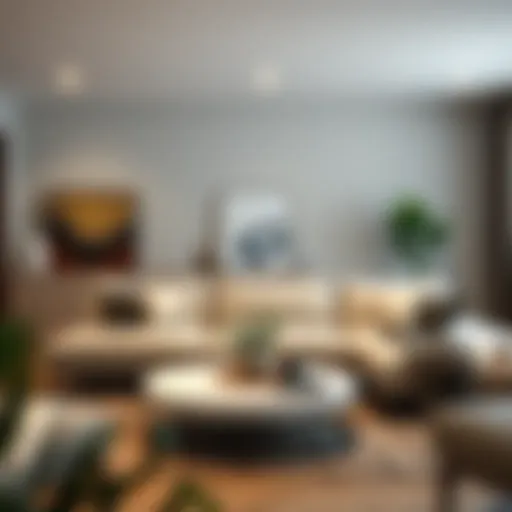Creative Strategies for Wall Photo Displays


Intro
In today's world, wall displays have evolved beyond mere decorations; they are a reflection of individual personality and style. A well-curated photo wall can speak volumes, capturing memories, aspirations, and artistic taste all at once. It’s not just about hanging pictures—I mean, that's like putting a Band-Aid on a broken leg. Instead, it’s a thoughtful alignment of images, frames, and spaces, creating a narrative that resonates with anyone who steps into the room.
Creating a wall display involves a multifaceted understanding of aesthetics, space usage, and, frankly, the art of letting one’s individuality shine through. But don’t worry, no need to turn into Picasso overnight. Whether you consider yourself a design buff or a casual DIYer, there’s a wide array of techniques and inspirations to guide you.
Consider the emotional weight carried by the images used—a candid shot of a family reunion, a breathtaking landscape from your travels, or, perhaps, an abstract piece that stirs contemplation. Each selection adds a layer to the storyline, enhancing the ambiance of your home. Along with that, choosing the right frames, layouts, and placement transforms your walls into a canvas for creativity.
As we delve deeper into the subject, this article will unravel various aspects such as the latest design trends, various styles, practical tips, ideal materials for display, and common missteps to steer clear of. So grab your favorite cup of coffee and prepare to turn those blank walls into something truly captivating.
Understanding the Importance of Photo Displays
Photo displays transcend mere decoration; they serve as emotional touchstones and visual narratives within our living spaces. When thoughtfully arranged, a wall adorned with images transforms an ordinary area into a personal gallery that reflects individual stories, experiences, and milestones. For homeowners, designers, and art aficionados alike, the importance of such displays not only lies in their aesthetic appeal but also in their ability to evoke memories and feelings.
The Role of Personal Artistry
A photo display is a canvas for one’s creativity. It’s not just about slapping a few pictures on the wall; it’s an opportunity to express one’s personality and taste. Each selection becomes a brushstroke in this living art piece. For instance, consider a family that curates a dynamic wall with snapshots of various trips. This collection goes beyond the images; it creates a feel of adventure, togetherness, and shared memories that can evoke nostalgia every time someone walks by.
Moreover, using personal artistry in photo displays can introduce unique elements to interior design. Whether it’s a bold arrangement that makes a statement or a soft, harmonious layout that subtlety blends into the surrounding decor, each style can influence the mood of a space. Through color selection, frame choices, and image placements, homeowners have the freedom to transform walls into a reflection of who they are.
Creating a Narrative Through Imagery
Every photograph tells a story, and when compiled thoughtfully, these stories can weave together a larger narrative. Imagine entering a room where each frame recounts a chapter of a family’s history or chronicles a beloved pet’s life. This narrative approach invites viewers to engage with the display, sparking curiosity about the moments captured within the frames.
An effective display can take the audience on a visual journey. For example, a series of images starting from a couple's wedding day, moving through the birth of their children, and culminating in recent family vacations not only hangs on the wall but illustrates the evolution of their lives together. These stories enhance the emotional connection individuals have to the space, cementing the idea that a home is much more than just bricks and mortar.
"A wall of memories becomes a canvas of emotions, inviting stories to unfold with every glance."
Choosing the Right Location
Choosing the right location for your photo displays is a critical aspect of creating an engaging and personalized visual narrative in your space. The placement of photographs can dramatically change the ambiance and character of a room, making it essential to consider both functionality and aesthetics. Finding the perfect spot not only enhances the visual appeal but also ensures that the photographs serve their intended purpose, whether that's to evoke memories or simply add an artistic touch.
When selecting a location, various elements come into play. Factors such as foot traffic, lighting conditions, and the overall décor of the room can significantly influence your decision. A well-placed photo display can serve as a conversation starter, drawing guests’ eyes and encouraging interaction. Additionally, it can reflect your personality and style, adding depth and individuality to your home environment.
High Traffic Areas vs. Private Spaces
High traffic areas, like hallways or entryways, offer a fantastic opportunity to showcase your photo displays prominently. These spots are often the first impressions for visitors, making them ideal for showcasing family portraits or memorable travel imagery that tells a story about you and your loved ones. However, it’s crucial to ensure that the arrangement doesn't feel overcrowded. An over-cluttered display may take away from the significance of each photograph, burying beautiful memories beneath a sea of images.
On the other hand, private spaces such as bedrooms or intimate nooks allow for a more personal and reflective photo display. Here, the chosen images can evoke emotions, offering a sense of comfort and nostalgia in a more relaxed setting. The narrative displayed in these areas can be tailored to inspire confidence or relaxation, enhancing the overall atmosphere of your personal sanctuary.
Balancing Light and Shadow
Understanding the dynamics of light and shadow is vital when selecting the location for your photo displays. Natural light can brighten up photographs and bring out their colors, but too much direct sunlight can lead to fading over time, diminishing the vibrancy of your cherished images. This is why finding a balance is paramount.
Consider the following tips:
- Positioning: Place photos in locations where they will receive ample light without being directly exposed to harsh rays.
- Shadow Play: Utilize shadow to create depth. Darker corners can add drama and highlight the photographs, while well-lit areas can enhance emotional warmth.
- Artificial Lighting: If natural light is scarce, use accent lighting to emphasize your display. Spotlights or soft wall sconces can effectively draw attention to your wall art without overwhelming it.
"A well-placed photograph can speak volumes; it becomes a portal to memories and emotions. Finding the correct balance between high traffic and personal space, as well as managing light, unlocks the true potential of a photo display."
In summary, the journey of creating a beautiful photo display begins with selecting the right location. Whether it's in bustling corridors or quiet corners, each spot offers unique insights into your life. Considering elements like foot traffic and lighting can significantly enhance your display, making your home a true reflection of who you are.
Design Principles for Effective Displays
When it comes to creating wall photo displays, understanding the design principles is crucial. These principles guide how images are arranged to maximize visual impact and ensure harmony within a space. Effective design transcends mere aesthetics; it shapes the way viewers interact with the displayed images, evoking emotions and memories. Before diving into practical execution, it's essential to grasp these foundational concepts that make a display resonate.
The Power of Grouping
Grouping images effectively is one of the most potent tools in display design. This technique allows you to curate a visual story, guiding viewers through a narrative that flows with the arrangement. Think of a grouping as a family reunion—each individual photo represents a different family member, yet collectively they convey a rich shared history.
When deciding how to group images, consider:
- Theme: Are there common themes, like travels, moments of joy, or family milestones? Grouping by theme adds context and makes the display relatable.
- Framework: Using a consistent framework—like a grid or a free-form layout—can solidify the cohesion of the group. For example, a perfectly aligned grid gives a modern, clean aesthetic, while a free-form layout may feel more dynamic and personal.
- Spacing: The distance between images plays a significant role in how they interact. Too much space can fragment the display, while too little can create chaos. Strive for balance.


"Grouping images transforms disparate moments into a cohesive story, inviting viewers into a visual dialogue."
Harmonizing Sizes and Shapes
The size and shape of photos are instrumental in shaping a display's overall appeal. Imagine a display made up entirely of square photos; now contrast that with a layout that incorporates rectangular and circular frames. The latter creates visual interest by breaking monotony. Harmonizing sizes and shapes gives rhythm to the wall, steering the viewer's eye across the display.
Consider these points when working with differing sizes:
- Proportionality: Larger images naturally draw the eye. Position these strategically—perhaps in the center or as anchors within smaller images—to guide viewers gently through the display.
- Variability: Mix portrait and landscape orientations to add dynamism. By alternating shapes and sizes, you can create a piece that feels alive and breathing rather than stagnant.
- Balance: Ensure that the weight of the display feels even. A heavy large photo on one side can overwhelm a display if not counterbalanced by similarly substantial pieces on the other side.
Color Cohesion and Contrast
Color is one of the most influential aspects of any visual display. It has the power to create mood and focus. Tying together the color palette is crucial for achieving a seamless look, whilst strategic contrasts can highlight essential details. Consider how the colors within your photos play against the wall color and each other.
Here’s how to work with color effectively:
- Cohesion: Choose a color scheme—whether it's complementary or monochromatic—that relates the photos. This creates an intrinsic connection between the images.
- Contrast: Juxtaposing bright images against a dark wall or vice versa can create a striking effect. Be mindful that too much contrast can be jarring; subtlety often yields a more sophisticated outcome.
- Accents: Consider incorporating accent colors from the images into the frames or surrounding decor. This pulls the whole display together and enhances its visual narrative.
These design principles—grouping, harmonizing sizes, and managing color—form the backbone of effective wall photo displays. By thoughtfully integrating these elements, individuals can transform a simple collection of photographs into a meaningful, well-designed visual experience.
Different Styles of Photo Displays
When considering the various ways to display photographs on walls, it’s crucial to acknowledge how different styles can transform any space. These styles not only showcase personal artistry but also communicate the owner's aesthetics and tastes. Selecting a style for your photo display can bring cohesion to the room, create focal points, or even introduce a narrative element to your storytelling. Choosing between eclectic arrangements, minimalist approaches, or gallery walls significantly impacts how viewers experience the imagery.
Eclectic Arrangements
Eclectic arrangements are a breath of fresh air, especially for those who thrive on variety and character. This style grabs attention by featuring a mix of photos in different sizes, styles, and frames. It’s the visual equivalent of a mixtape; each piece adds its unique flavor to the overall composition. Here are a few pointers:
- Diversity in Frames: Incorporate different materials like wood, metal, or even a vintage find. An array of colors and textures can complement one another beautifully.
- Thoughtful Placement: Place pieces at varying heights for an organic feel. Take care not to shy away from overlap. This can create an interesting narrative.
- Personalization: Include items that reflect your life experiences—concert tickets, postcards, or small art pieces that resonate with you.
The beauty of this style is that it allows for creativity without strict guidelines. It’s all about forming a connection with the audience through personal memories and experiences.
Minimalist Approaches
On the other side of the spectrum are minimalist approaches. This style is marked by simplicity and restraint. Think of it as the fine art of saying less but saying it beautifully. It’s particularly suitable for modern spaces where a clutter-free look is desirable. Here’s how to make a minimalist display effective:
- Selective Choices: Choose a few impactful images that resonate deeply with you. Display them prominently, often in large formats for greater visual impact.
- Consistent Framing: Use similar frames or color schemes to build uniformity. Black and white frames tend to work well, but gently mixing materials like wood with monochrome can create a nice effect without straying from simplicity.
- Negative Space: Leave plenty of wall space around images to let them breathe. The absence of additional décor draws focus to the photos themselves.
This approach appeals to those who prefer understated elegance and have a keen eye for quality over quantity.
Gallery Walls
Gallery walls are perhaps the most dynamic of photo display styles, offering a larger canvas to express personal interests and hobbies. This style can be curated to feel like a walk through an art exhibit by meticulously arranging a collection. Here are some key ideas:
- Theme and Cohesion: Create a central theme, such as travel photos or family portraits. This builds a narrative and gives viewers a storyline to follow.
- Grid or Organic Layouts: Layout can be structured with a symmetrical grid pattern or more relaxed, organic placement that flows like a stream. Both have their beauty, but consider your space and how it will be perceived.
- Incorporating Non-Photo Elements: Add in some decorative pieces, artworks, or quotes to add more depth. These can bring layers of context to the visuals.
Each display element within a gallery wall invites discussion and attracts attention, turning a simple collection of images into a captivating display of life and memories.
The style you choose significantly impacts not only the aesthetic of your home but also the way your personal story is framed for guests to see.
Materials and Frames for Photo Displays
When it comes to showcasing photographs on your walls, the choice of materials and frames stands as a pivotal element in achieving a polished look. The right frame not only serves as a physical boundary for the image but also plays a crucial role in emphasizing the content. So, when planning your photo display, taking a moment to consider which materials will complement your art is essential. Here, we delve into the different kinds of materials and frameworks, exploring their benefits and how they contribute to the overall aesthetic of your space.
Wooden Frames: Classic and Timeless
Wooden frames have long been adored for their natural beauty and versatility. This classic choice fits seamlessly into various home styles, from rustic to contemporary. The grain and texture of wood add a layer of warmth that metal frames simply can’t replicate.
- Durability and Longevity: Well-crafted wooden frames can last for generations if properly maintained. Their sturdy nature provides solid protection for your photographs while giving them an appealing backdrop.
- Versatile Finishes: Wooden frames come in a multitude of stains, paints, and finishes, allowing homeowners to pick an option that aligns with their decor. Whether you prefer a polished mahogany or a weathered barn wood look, the options are nearly endless.
- Personal Touch: For those with a flair for DIY, wood frames offer an opportunity for customization. You could sand, paint, or carve the frame to add personal touches, making it not just a frame but a piece of art themselves.


Metal and Acrylic Options
For a more modern feel, metal and acrylic frames offer a sleek and contemporary alternative to traditional wooden frames. They often bring a sense of minimalism and elegance to a photo display.
- Sleek Aesthetic: Metal frames come in finishes like brushed aluminum and glossy chrome, appealing to those who prefer a clean look. Their slim profile allows the photographs themselves to take center stage.
- Lightweight and Easy to Handle: Acrylic frames, on the other hand, are incredibly lightweight. This makes hanging and rearranging displays simpler and less cumbersome.
- UV Protection: Many acrylic frames come with UV-resistant properties, helping to protect your images from fading over time, maintaining the vibrancy of your collection.
Eco-Friendly Choices
In today’s world, conscious consumption has gotten quite a bit of attention, and for good reason. Eco-friendly materials are increasingly popular among those looking to make sustainable decisions.
- Recycled Materials: Many manufacturers now offer frames crafted from recycled wood, giving new life to previously discarded products and reducing waste.
- Biodegradable Options: Frames made of bamboo or cork are renewable resources, proving to be excellent environmentally-friendly material choices.
- Art with a Conscience: By opting for eco-friendly frames, you not only enhance your decor but also reflect your values, making your photo display a conversation starter for sustainability.
"The frame is a picture's best friend; It gives it context and helps it shine."
Incorporating Textures and Depth
When it comes to wall photo displays, incorporating textures and depth can transform a static visual into a vibrant, engaging narrative. A flat wall adorned with framed photographs can feel one-dimensional and lackluster. By introducing various textures and employing depth, homeowners and designers can elevate their photo displays, ushering in an atmosphere that beckons for closer inspection. It’s about creating a feast for the eyes, inviting viewers to immerse themselves in the display rather than just glancing at it.
Layering Techniques
Layering techniques are essential for infusing life into a seemingly standard photo arrangement. The idea is to stack, overlap, or group images in a way that moves the eyes around the display, creating a sense of flow. This method allows for dynamic interaction between different elements. For instance, start with a large statement piece as the centerpiece, then add smaller photographs around it. Alternatively, a few floating shelves can provide the perfect platform to mix framed and unframed pieces, as well as physical objects.
Here are some practical tips for mastering layering:
- Use Variations in Frame Styles: Combining different frame styles and materials can create a layered effect. Think wooden, metal, and acrylic frames all working together to add visual intrigue.
- Mix Portrait and Landscape Orientations: Switching orientations among pictures adds contrast, breaking the monotony of alignment and prompting interest.
- Incorporate Objects: Consider adding items like small potted plants, books, or art pieces alongside your photos to introduce even more layers. This not only adds depth but also personal touch.
Creating depth through layering adds an element of sophistication, inviting observers to not only look but also explore. It creates a narrative that echoes personal journeys and memories.
Using Shelves for Added Dimension
In the world of photo displays, shelves can be an underrated powerhouse. By integrating shelves into your wall design, you don’t just hang photos—you create an interactive space that could engage visitors effectively. Shelves allow flexibility in how visuals are presented and help break up the rigidness of traditional framed arrangements.
Here are ways to enhance your display using shelves:
- Height Variation: Place shelves at various heights. This acts like a visual rhythm, drawing the eye upward and encouraging movement through the area. You can arrange photographs along with artifacts that resonate with your theme.
- Incorporate Dimension: Use deep or floating shelves to showcase not just framed photos but also sculptures, plants, or souvenirs that complement the images. The play of light and shadow can add another layer of depth, making the display more intriguing.
- Seasonal Rotations: Shelves allow easy swapping of items. You can celebrate different seasons or occasions by rotating the photos and items, ensuring the display feels fresh and thrilling throughout the year.
"Utilizing shelves in your display setup is not just practical; it's an artwork in itself, blending function with aesthetics that appeals to both the heart and the eye."
In summary, incorporating textures and depth through layering techniques and the strategic use of shelves can vastly improve the quality of wall photo displays. By embracing these approaches, you ensure that your photos tell stories, evoke emotions, and captivate anyone who steps into the space.
The Impact of Lighting on Displays
Light has an undeniable influence on how we perceive wall photo displays. When photos are displayed in a well-lit environment, their colors pop and details are sharper, enhancing the overall aesthetic and emotional impact. Additionally, the right lighting can create a mood and help set the tone of a room, making it vibrant or calming, depending on the ambiance you wish to achieve. By strategically using light, you can draw attention to certain pieces or create a cohesive look for a collection of images.
Natural Light Considerations
Natural light is a double-edged sword for photo displays. On one hand, it can illuminate and breathe life into your photographs, mimicking the real colors and textures. Sunlight streaming through a window can create a warm and inviting atmosphere. However, it comes with its pitfalls. Direct sunlight can cause fading over time, degrading the quality of prints and frames. It's wise to observe how sunlight moves through your space throughout the day.
Consider the orientation of your walls and the presence of sheer curtains or UV-protective films to minimize potential damage. If you plan to hang photographs facing the sun, framing them in UV-protective glass can help mitigate fading while still taking advantage of the natural light.
"Natural light brings out the life in your images but needs to be handled with care to prevent them from aging prematurely."
Accent Lighting Solutions
Accent lighting offers an opportunity to spotlight your photographs and can transform them into focal points within your space. Think of it as the cherry on top of your design cake. Whether it’s wall sconces, picture lights, or LED strips, these options can enhance and dramatize your displays.
For instance, a soft, warm light can create a cozy feel, while a cooler light may give a sleek, modern touch. Here are some ideas to explore when using accent lighting:
- Picture Lights: These are ideal for highlighting specific frames. Positioned above or on the side of the artwork, they cast even light without the risk of glare.
- LED Strip Lighting: This option can be discretely installed along shelves or behind frames for a modern flair, adding depth and intrigue to your arrangement.
- Track Lighting: This can be adjusted to shine light on different areas of your display, allowing flexibility to change the spotlight as your collection evolves.


When considering accent lighting, also explore dimmer switches to control intensity. This flexibility allows you to tailor the atmosphere for various occasions, from lively gatherings to peaceful evenings.
Achieving the right balance of lighting is crucial. It not only beautifies the space but elevates your photos, ensuring they are appreciated in all their glory.
Tips for Avoiding Common Mistakes
Creating a wall photo display can be exciting and fulfilling, but it also comes with its set of challenges. Avoiding common mistakes is as crucial as picking the right photos. When done correctly, a photo display enhances your interior space, turning it from ordinary to extraordinary. Here, we’ll pinpoint two of the most frequent missteps made during the curation of photo displays and offer practical solutions.
Overcrowding the Space
One of the most prevalent errors when designing a photo wall is overcrowding the space. It’s tempting to showcase every cherished memory, but cramming too many pieces together can backfire. Just imagine a beautifully plated dish overwhelmed by too many garnishes; the main course gets lost in the clutter. Similarly, a crowded photo display overwhelms the viewer, making it difficult to appreciate any single piece.
To avoid this pitfall, you should first take stock of your wall space. Measure it and visualize how each photo will fit. Here are some strategies:
- Choose Quality over Quantity: Select a few standout pieces that resonate with you, rather than throwing everything up on the wall.
- Establish a Theme: Whether it’s color, subject, or style, having a theme can reduce the temptation to clutter.
- Use Negative Space: Incorporating areas of ‘negative space’ around your photos allows each piece to breathe, making them pop rather than blend.
Less truly is more in the realm of photo displays. It creates focus, ensuring your photos get the attention they deserve.
Ignoring the Viewing Height
Another common misstep is not considering the viewing height of your photo display. Think about it: if your display is too high or too low, the impact can be significantly diminished, almost as if hiding a beautiful sculpture behind a curtain.
Understanding the human eye level is important for creating a visually engaging layout.
Here are a few important tips:
- Begin at Eye Level: Generally, the center of your display should be about 57 to 60 inches from the floor. This is usually where the average person's eyes will fall when standing.
- Consider Seating: If your display will be viewed primarily from a seated position, adjust accordingly. Make sure the frames are accessible and visible regardless of whether individuals are standing or sitting.
- Include Vertical Space: Use the height of the wall to your advantage. If your ceiling is lofty, consider whether to use it as a canvas for vertical arrangements, particularly in spaces like staircases or living rooms.
Effective displays showcase your moments while welcoming viewers to feast their eyes comfortably. By being mindful of how you utilize space and height, you can turn your wall into a captivating narrative that speaks volumes.
Maintaining and Updating Your Displays
Maintaining and updating photo displays is not merely a decorative task; it represents an evolving narrative of one’s life, experiences, and aesthetic preferences. A well-maintained display not only enhances the ambiance of a space but also communicates a sense of care and intention. Regular updates can breathe new life into a wall, reflecting seasonal changes, personal milestones, or shifts in style.
The importance of keeping things fresh cannot be overstated. In a world that changes faster than a blink, your home should tell a dynamic story that resonates with who you are at different moments in time. A routine check-in on your wall displays can help avoid overshadowing cherished memories with old and dusty frames, introducing a vital interest in what surrounds you and your family. Indeed, a cluttered or outdated photo display can detract from the beauty of your home, while a thoughtfully curated one can elevate it immensely.
Seasonal Updates
Seasonal updates are a unique way to keep your photo displays lively and engaging. Just like changing out your wardrobe when the weather shifts, refreshing your displays to reflect seasonal themes can create a delightful experience for your household and guests alike.
- Winter Wonder: In the colder months, you might swap out bright summer photos with images that capture the serene beauty of winter or cozy family gatherings around the fireplace.
- Spring Awakening: With the arrival of spring, consider integrating photographs taken during outdoor adventures as the blooms come to life. This could include vibrant colors of flowers or family outings in nature.
- Summer Sunshine: For the summer months, vibrant vacation photos or lazy beach days can bring a joyful energy to your spaces.
- Autumn Tones: In the fall, photos featuring seasonal landscapes can conjure memories of crisp air and golden leaves, introducing warmth to your decor.
Updating each season not only keeps the decor interesting but also stimulates conversations and memories tied to those photos. It’s a simple way to ensure that your photo displays reflect your current tastes while encouraging reflection on cherished moments.
Repairing and Refreshing Frames
Frames play an essential role in enhancing the visual appeal of your photo displays, yet they can become worn or damaged over time. Regularly inspecting frames ensures that they continue to complement the memories they encase rather than detract from them.
- Assessing Condition: Look for signs of wear—for instance, scratches, chips, or wobbly corners that may need realignment.
- Cleaning Techniques: Dust accumulation can dull the beauty of both the frame and the image. A gentle cleaning with a microfiber cloth and perhaps a little wood polish can rejuvenate wooden frames, whereas glass frames might need a glass cleaner for a crystal-clear finish.
- Color Refresh: Changing the color of a frame can give your overall display a fresh feel. Whether through painting an old frame or adding a new finish, updating the look can make a huge difference.
- Style Alignment: It’s also worth considering if the frames still fit your current aesthetic. Sometimes, a simple swap for a more modern style can bring everything together beautifully.
Keeping your frames in prime condition and aligning them with current design trends ensures your art is showcased at its best, allowing each photo to shine as it should, contributing to the overall narrative you want to present in your home.
"A frame may seem like a simple border, but when chosen wisely, it becomes a statement; it enhances, complements, and sometimes even transforms, the heart of a photograph."
Engaging with the maintenance and update processes for your displays is vital in cultivating an inviting and expressive home environment. By incorporating seasonal changes and focusing on maintaining your frames, you not only create a visually interesting display but also fortify the emotional resonances that your photos are meant to evoke.
Epilogue: Elevating Spaces with Personal Touches
Creating a wall photo display is more than just hanging pictures; it's about expressing who you are and what matters to you. This article has journeyed through various intricate aspects—like choosing proper locations, understanding design principles, selecting materials, and so on—to showcase how personal artistry transforms a mere wall into a storyteller. The act of curating these displays allows homeowners, designers, and even DIY enthusiasts to mold their spaces, making them resonate with individual stories and emotions.
The unique benefit of dedicating time to elevate a space with personal touches is twofold. First, it fosters a connection to the environment; every glance at a thoughtfully placed photo can ignite nostalgia or joy. Each image tells a story that contributes to a larger narrative within your home, reflecting shared moments, experiences, and relationships. This approach encourages viewers—whether it’s family, friends, or even strangers—to linger, to ponder, and to connect with the essence of your life’s journey.
Second, personalized displays serve to enhance the aesthetic quality of any interior. Cramming random artwork can lead to chaos, but combining a well-thought-out theme with a careful selection of textures and colors breathes life into a room.
"Your walls are the blank canvases of your life, and every display offers a chance to paint your experiences in bold strokes."
By choosing images that resonate and arranging them in ways that are pleasing to the eye, you surely can make a statement through design that echoes sophistication and intention. Artfully laid out, your display not only declares something about who you are, but also enhances the ambiance of your living or working space, inspiring all who encounter it.















